Greetings, fellow Stargazers! Have you been enjoying the rain? Then keep your eyes open for a “celestial shower” as meteoritic activity picks up over the next few nights, culminating in the peak of the Ophiuchid meteor Saturday night through Sunday morning. While you’re out relaxing, be sure to spare some time for lunacy and take a look some interesting features on the Moon. Need a test of your telescope’s resolving power? Then I “double dare” you to take on Gamma Virginis! Whenever you’re ready, I’ll see you in the back yard….
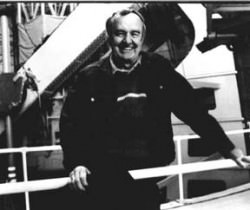 Friday, June 18, 2010 – Let’s begin the day by recognizing the 1799 birth on this date of William Lassell, telescope maker and discoverer of Triton (a moon of Neptune), and Ariel and Umbriel (satellites of Uranus). As often happens, great astronomers share birth dates, and this time it’s 187 years later for Allan Rex Sandage. A Bruce Medalist, Dr. Sandage is best known for his 1960 optical identification of a quasar, with his junior colleague, Thomas Matthews.
Friday, June 18, 2010 – Let’s begin the day by recognizing the 1799 birth on this date of William Lassell, telescope maker and discoverer of Triton (a moon of Neptune), and Ariel and Umbriel (satellites of Uranus). As often happens, great astronomers share birth dates, and this time it’s 187 years later for Allan Rex Sandage. A Bruce Medalist, Dr. Sandage is best known for his 1960 optical identification of a quasar, with his junior colleague, Thomas Matthews.
Our telescope lunar challenge tonight will be Hadley Rille. Find Mare Serenitatis and look for the break along its western shoreline that divides the Caucasus and Apennine mountain ranges. South of this break is the bright peak of Mons Hadley, which is of great interest for several reasons, so power up as much as possible.
Impressive Mons Hadley measures about 24 by 48 kilometers at its base and reaches up an incredible 4,572 meters. If volcanic activity had created it, Mons Hadley would be comparable to some of the very highest volcanically formed peaks on Earth, like Mount Shasta and Mount Rainer. South is the secondary peak, Mons Hadley Delta. It is home to the Apollo 15 landing site just a breath north of where it extends into the cove created by Palus Putredinus. Along this ridge line and smooth floor, look for a major fault line, winding its way across 120 kilometers of lunar surface; this is Hadley Rille. In places, the Rille spans 1,500 meters in width and drops to a depth of 300 meters below the surface. Believed to have been formed by volcanic activity 3.3 billion years ago, we can see the impact lower gravity has on this type of formation. Earthly lava channels are usually less than 10 kilometers long, and only around 100 meters wide. During the Apollo 15 mission, Hadley Rille was visited at a point where it was only 1.6 kilometers wide, still a considerable distance. Over a period of time, the Rille’s lava may have continued to flow through this area, yet it remains forever buried beneath years of regolith.
Saturday, June 19, 2010 – Tonight on the Moon we’ll be looking for another challenging feature and the craters that conjoin it—Stofler and Faraday. Located along the terminator to the south, crater Stofler was named for Dutch mathematician and astronomer Johan Stofler.
Consuming lunar landscape with an immense diameter of 126 kilometers, and dropping 2,760 meters below the surface, Stofler is a wonderland of small details in an eroded surrounding. Breaking its wall on the north is Fernelius, but sharing the southeastern boundary is Faraday. Named for English physicist and chemist Michael Faraday, this crater is more complex and deeper (4,090 meters) but far smaller in diameter (70 kilometers). Look for myriad smaller strikes that bind the two together!
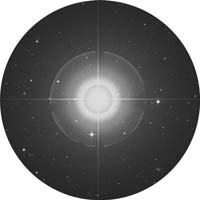 When you’re done, let’s have a look at a delightful pair—Gamma Virginis (RA 12 41 41 Dec +01 26 54). Better knownas Porrima , this is one cool binary whose components are of almost equal spectral type and brightness. Discovered by Bradley and Pound in 1718, John Herschel was the first to predict this pair’s orbit in 1833, and stated that one day they would become inseparable to all but the very largest of telescopes—and he was right. In 1920 the A and B stars had reached their maximum separation, and during 2007 they were as close together as they ever can be. Observed as a single star in 1836 by William Herschel, its 171-year orbit puts Porrima in almost the same position now as it was when Sir William saw it!
When you’re done, let’s have a look at a delightful pair—Gamma Virginis (RA 12 41 41 Dec +01 26 54). Better knownas Porrima , this is one cool binary whose components are of almost equal spectral type and brightness. Discovered by Bradley and Pound in 1718, John Herschel was the first to predict this pair’s orbit in 1833, and stated that one day they would become inseparable to all but the very largest of telescopes—and he was right. In 1920 the A and B stars had reached their maximum separation, and during 2007 they were as close together as they ever can be. Observed as a single star in 1836 by William Herschel, its 171-year orbit puts Porrima in almost the same position now as it was when Sir William saw it!
 Sunday, June 20, 2010 – In the predawn hours, we welcome the ‘‘shooting stars’’ as we pass through another portion of the Ophiuchid meteor stream. The radiant for this pass lies nearer Sagittarius, and the fall rate varies from 8 to 20 per hour, but the Ophiuchids can sometimes produce more than expected! Perhaps the sky acknowledges the 1966 passing of Georges Lemaitre on this date? Lemaitre researched cosmic rays and the three-body problem and in 1927 formulated the Big Bang theory using Einstein’s theories.
Sunday, June 20, 2010 – In the predawn hours, we welcome the ‘‘shooting stars’’ as we pass through another portion of the Ophiuchid meteor stream. The radiant for this pass lies nearer Sagittarius, and the fall rate varies from 8 to 20 per hour, but the Ophiuchids can sometimes produce more than expected! Perhaps the sky acknowledges the 1966 passing of Georges Lemaitre on this date? Lemaitre researched cosmic rays and the three-body problem and in 1927 formulated the Big Bang theory using Einstein’s theories.
Are you ready to explore some more history? Then tonight have a look at the Moon and identify Alphonsus; it’s the centermost in a line of rings and looks much like the Theophilus, Cyrillus, and Catharina trio.
Alphonsus is a very old Class V crater, spans 118 kilometers in diameter, drops below the surface to about 2,730 meters, and contains a small central peak. Eugene Shoemaker had studied this partially flooded crater and found dark haloes on the floor. Again, this could be attributed to volcanism. Shoemaker believed they were maar volcanoes, and the haloes were dark ash. Power up and look closely at the central peak, for not only did Ranger 9 hard land just northeast, but this is the only area on the Moon where an astronomer has observed a change and backed up that observation with photographic proof.
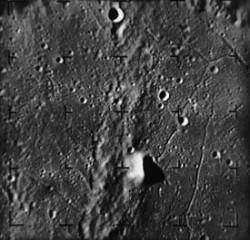 On November 2, 1958, Nikolai Kozyrev long and arduous study of Alphonsus was about to be rewarded. Some two years earlier Dinsmore Alter had taken a series of photographs from the Mt. Wilson 60’’ reflector that showed hazy patches in this area that could not be accounted for. Night after night, Kozyrev continued to study at the Crimean Observatory, but with no success. During the process of guiding the scope for a spectrogram, the unbelievable happened—a cloud of gaseous molecules containing carbon had been captured! Selected as the last target for the Ranger series of photographic missions, Ranger 9 delivered 5,814 spectacular high-resolution images of this mysterious region before it crashed nearby. Capture it yourself tonight!
On November 2, 1958, Nikolai Kozyrev long and arduous study of Alphonsus was about to be rewarded. Some two years earlier Dinsmore Alter had taken a series of photographs from the Mt. Wilson 60’’ reflector that showed hazy patches in this area that could not be accounted for. Night after night, Kozyrev continued to study at the Crimean Observatory, but with no success. During the process of guiding the scope for a spectrogram, the unbelievable happened—a cloud of gaseous molecules containing carbon had been captured! Selected as the last target for the Ranger series of photographic missions, Ranger 9 delivered 5,814 spectacular high-resolution images of this mysterious region before it crashed nearby. Capture it yourself tonight!
Until next time? Ask for the Moon… But keep on reaching for the stars!
This week’s awesome images are (in order of appearance): Dr. Alan Sandage courtesy of Dr. Sandage, Hadley Rille, courtesy of Wes Higgins, Stoffler and Faraday courtesy of Wes Higgins, Porrima – Palomar Observatory courtesy of Caltech, Georges Lemaitre and Albert Einstein (historical image), Ranger 9 Image of Alphonsus taken 3 minutes before impact courtesy of NASA, Alphonsus’ central peak taken 54 seconds before Ranger 9 impact courtesy of NASA. We thank you so much!



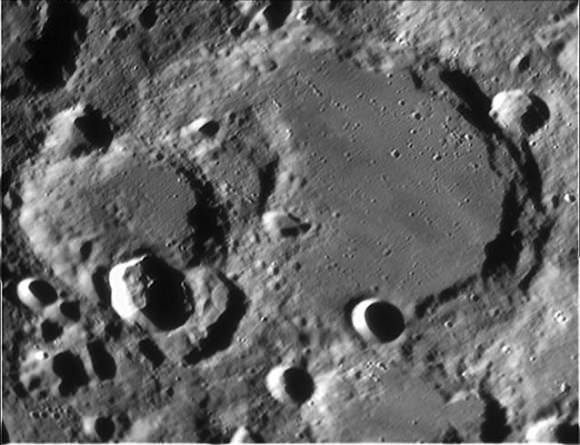
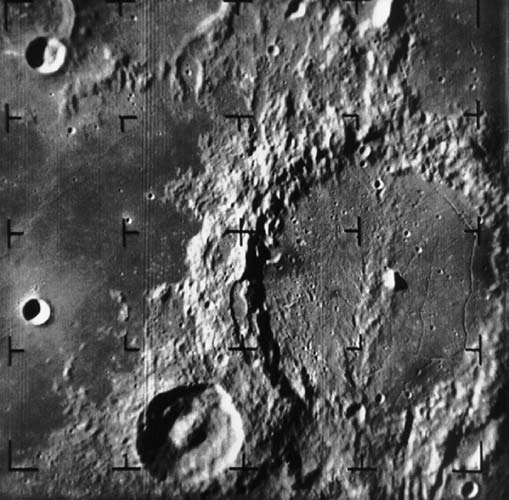
Well alrighty Tammy! Thanks for the lunar viewing inspiration(s)!
I finally got to see C/2009 K5 (McNaught) yesterday morning. One of our two cat’s, Mdm. Maxie, the twenty something female, has taken to howling like there’s no tomorrow every morning at about that time – and for her, well days are numbered? So… since I was up anyway I went out into the back yard and spotted the comet with my 7X35 binocs. It was up much higher than I’d assumed… It moves over into the evening sky later late June(?) early July. Using the 7X35’s I was able to make out the coma easily enough, but not much else detail wise. Was too tired (or lazy?) to break out one of my telescopes…. but soon!
This was the 42nd comet I’ve seen! I likes comets!
Don’t forget – the leader of the Lakota Dakota Nakota Oyate Sioux nation, Chief Arvol Looking Horse, has a message and request for all the people of the Earth. He, while visioning, saw a great danger threatening “Grandmother Earth” and a great hope for restoring her wholeness. So he is calling all nations to prayer of any kind on June 21st in an effort to return the planet to balance and the people to spirit. “On June 21st we’re asking people to go to their sacred places or sacred spaces to pray.”
YAH tah hey! – And so it is! I for one intend to go to the Kashiya village site along the nearby Russian River and making a sacred circle by offering corn meal, tobacco and some brandy… and praying… especially for the users of gasoline and oil products.
I easily observed this comet at about 3:30am last weekend (about 10:30 2010-Jun-13 UT) under dark skies out in the Anza Borrego desert. In 10×50 Orion Ultraview binoculars the comet was an obvious greenish fuzzy star with a tail about 1.5 to 2 degrees long. A pretty sight just above the ridge line at that site. I wish I had thought of bringing my DLSR and tripod along.
In my 45cm f/4.5 Newtonian telescope with a 31mm eyepiece (about 70x) the color seemed to be more a blue-green. The nucleus was very bright with a round coma. The tail was needle like straight to the NW but if you looked near the coma’s outer edge you coud see a lot more ‘spikes’ or ‘jets’ (none anti) in a 120 degree arc.
Around 4am, when I turned in for the night, I tried to see it naked eye. Knowing exactly where it was in relational to the Perseus association cluster allowed me to just eek it out. I’d not have seen it if I had not known exactly where to look. Prolly 5 or 6th mag.
Still quite memorable. Ya gotta love communing with the sky in the early morning before dawn with a comet gliding through the quiet. Lovely.